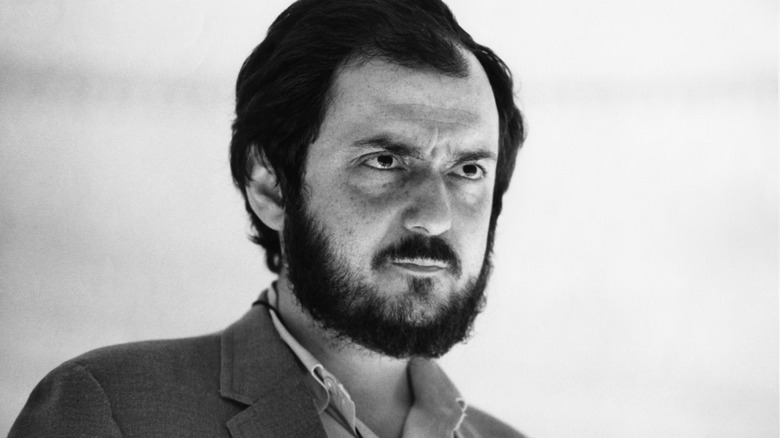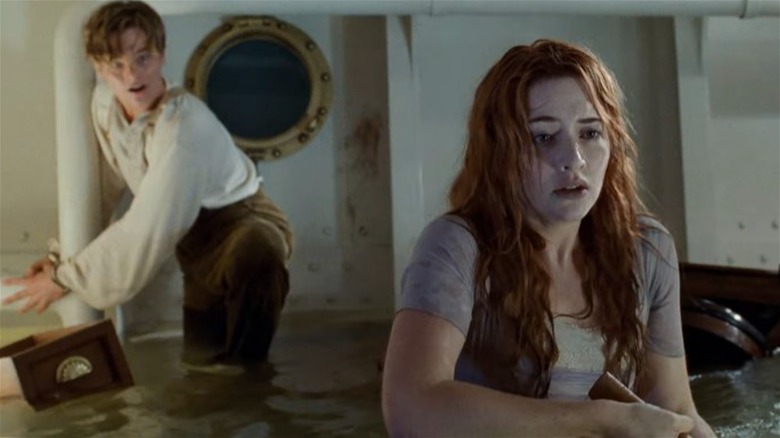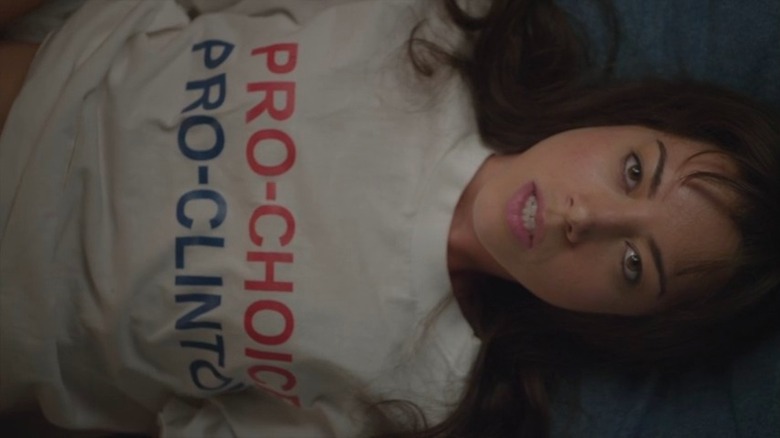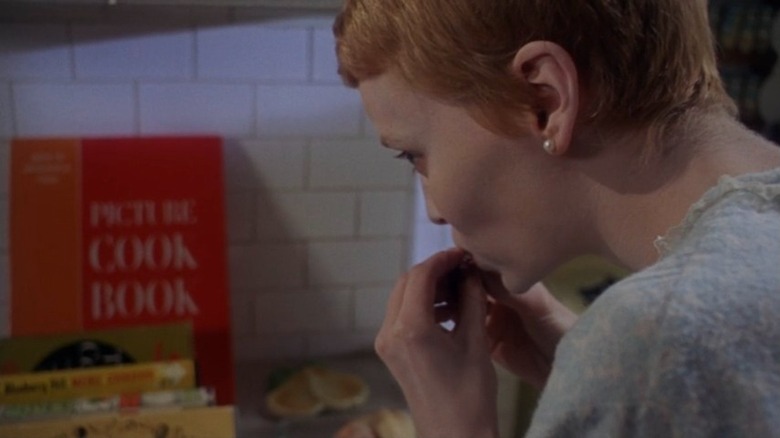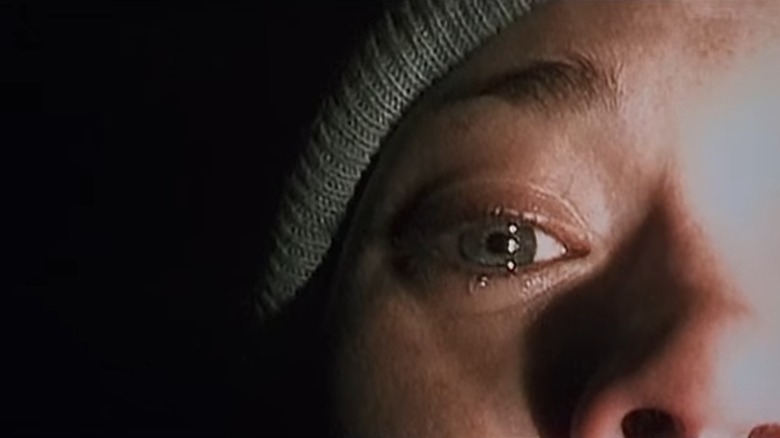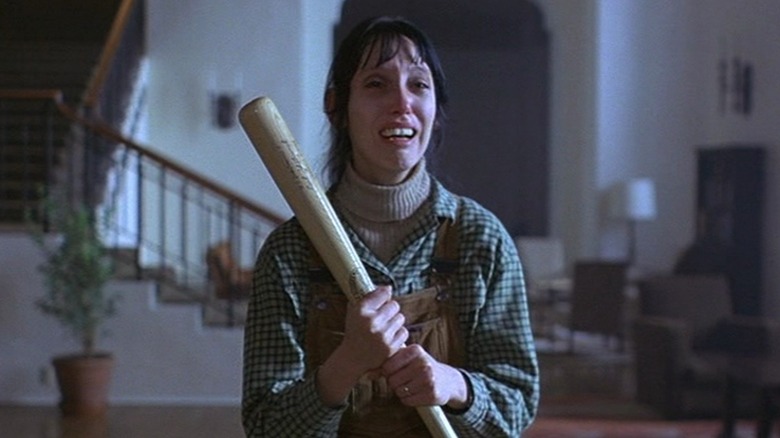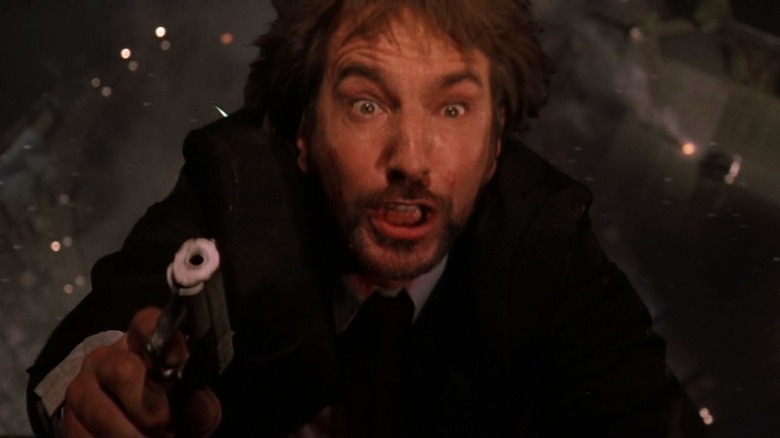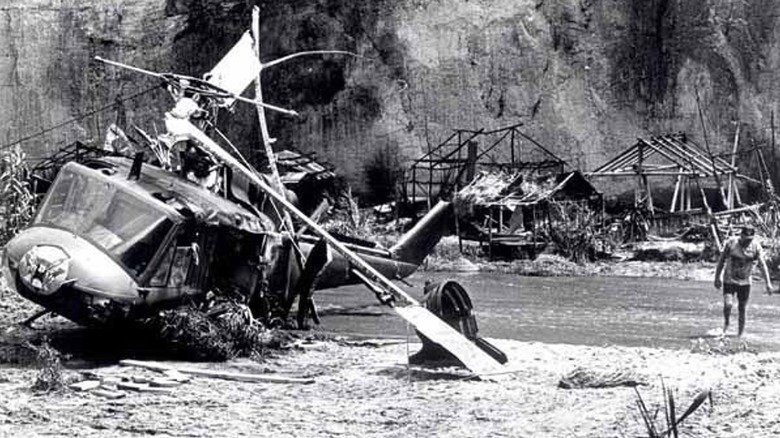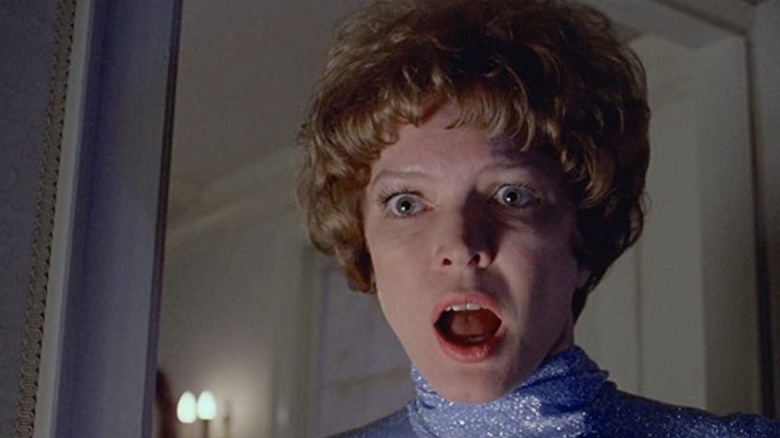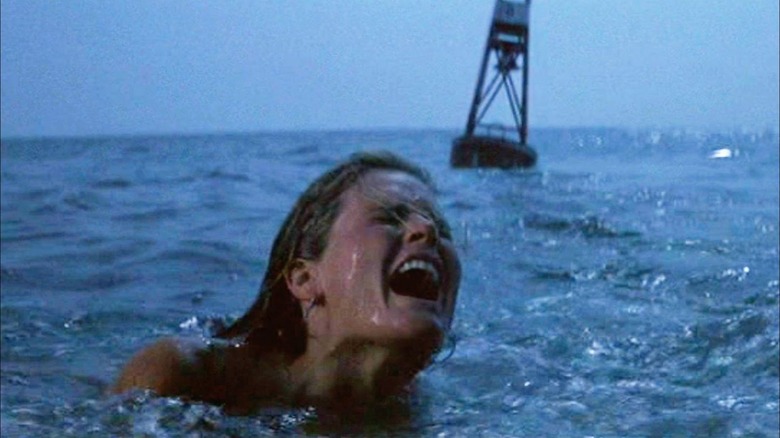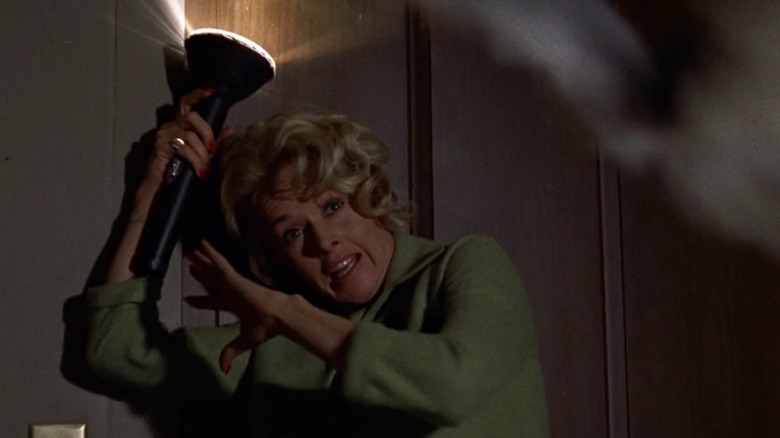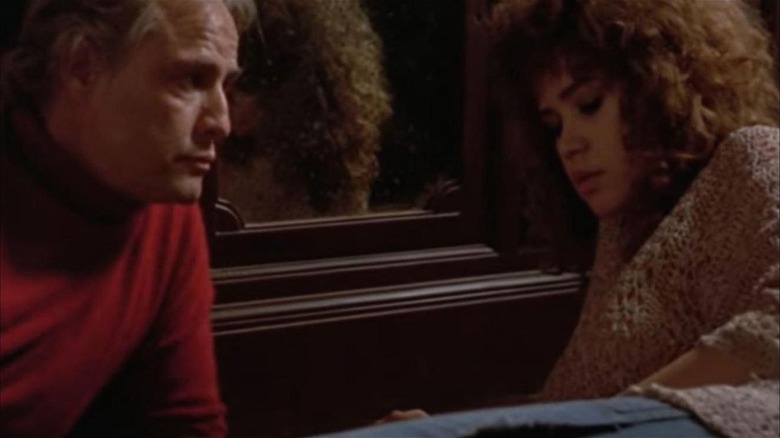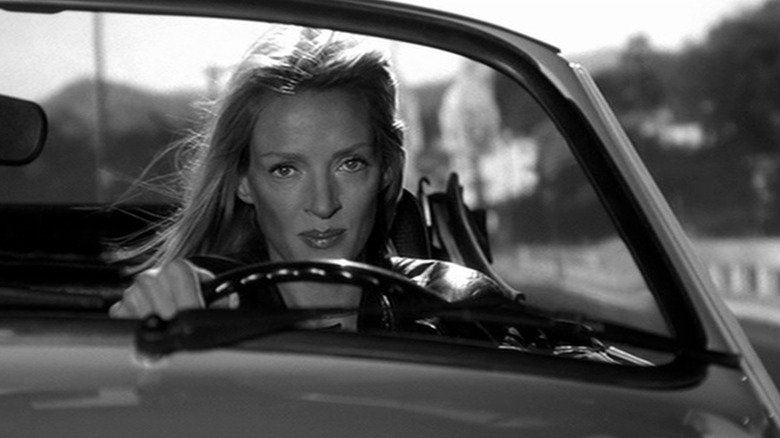Times Directors Brutally Crossed The Line For The Sake Of A Scene
There's a skill that all actors possess, and while some are much better at it than others, it's universal: they act. This means that you can take an actor and place them into a scene, and they'll pretend they're scared, aroused, angry, or whatever a scene requires. This is true of all people in the profession, so when a director decides that they need to go above and beyond to evoke more from their actors, people take notice.
Unfortunately, this often results in some performers having a terrible time on set, and, as you'll see, it primarily impacts women. Sure, there's the occasional extra step a director will take for their male actors, but a disturbing number of directors tend to cross the line for a scene when a female actor is the subject. That said, the film industry has a checkered past (and present) when it comes to misogyny, and those who bear the brunt of it haven't all remained quiet.
When a director, even one we hold in high regard, pushes things beyond the reasonable or expected, they may get the scene they want, but at the cost of anyone involved. Numerous permanent injuries, mental anguish, and other traumatic experiences have befallen actors in such instances. Some of the lengths directors have gone to in order to get everything "just right" may surprise you.
James Cameron - Titanic - Rose rescues Jack
James Cameron sweats the details and will do anything to make a movie work. He invests years in his projects and often takes ages between producing them. Despite not going to film school, Cameron repeatedly demonstrates his remarkable ability to tell a story in a powerful and digestible way, and that's especially true of "Titanic."
When the Titanic sank, it did so in water that was around 28 degrees, which explains why Jack (Leonardo DiCaprio) froze to death. In the film's third act, the ship takes on a lot of water, and Rose (Kate Winslet) rushes into the lower decks to locate Jack. She finds him cuffed to a pipe and must use an axe to free him. If you look closely, you'll notice Rose shivering quite a bit.
Cameron could have heated the water but chose to leave it be. Winslet was on board despite her discomfort. As she explained in an interview with Rolling Stone, "There were moments of despair when I thought, 'God, this is so tough, and I'm so tired.' And, yes, the water was cold. But, y'know, I have to say, at the end of the day, I wouldn't have had that water heated. I said to Jim, 'Please don't make that tank hot because then we can't really know what it would have felt like.'"
Maggie Carrey - The To-Do List - The masturbation scene
The rom-com coming-of-age film "The To-Do List" centers around recent high school graduate Brandy Klark (Aubrey Plaza). Because she feels she needs a bit more experience exploring her sexuality before beginning college, Brandy sets a goal to have sex with her crush and finish her to-do list. The film examines Brandy's sexuality through a variety of scenes and includes a somewhat explicit sequence in which Brandy masturbates on a bed — with the camera directly above Plaza.
Maggie Carrey directed the film, and when Plaza asked about the scene, Carrey flat-out told her to masturbate for real. Plaza could have easily pretended to do this as part of her craft, but the director adamant said that she needed to do it for real. Plaza opened up about the scene and her directions for it during an appearance on "Conan" in 2013. Plaza imagined the camera would pan up as her hand went down, but Carrey had other ideas.
"I thought I was doing one thing, and then when I showed up, it was a whole different thing," Plaza told Conan O'Brien. "It was a full-body shot ... I asked the director, 'What should I do?' And she said, 'Masturbate like it says in the script.'" To her credit, despite being incredibly uncomfortable, Plaza did as instructed, and Carrey has called Plaza brave and said that she was game for everything she asked of her.
Roman Polanski - Rosemary's Baby - Eating raw livers
Roman Polanski ranks as one of the most infamous directors of his generation, but not for his skills in a director's chair. Polanski's criminal exploits notwithstanding, the man has helmed some of cinema's greatest films, including 1968's "Rosemary's Baby." It stars Mia Farrow as a young, married (and soon pregnant) woman, Rosemary Woodhouse, who believes her neighbors are Satanists intent on using her child for some nefarious purpose.
The film gained notoriety for the behind-the-scene clash between Polanski and his leading man, John Cassavetes. Still, the movie was made and stands as one of the best psychological thrillers of the 1960s. However, several scenes pushed Farrow to her limits, and she gives an outstanding performance. One such scene involves Woodhouse walking straight through traffic, and Polanski reportedly walked beside Farrow, filming it because "nobody will hit a pregnant woman" (via Time).
An even more notorious scene involves Farrow eating raw chicken livers, and there's nothing fake about it. Polanski compelled Farrow to eat raw chicken liver, which is dangerous. Still, she did it, as she explained in her memoir, "What Falls Away": "When Roman wanted me to eat raw liver, I ate it, take after take, even though, at the time, I was a committed vegetarian." Farrow showed true dedication to her craft, while Polanski pushed the limit of what was safe and necessary.
Daniel Myrick and Eduardo Sánchez - The Blair Witch Project - Everything
"The Blair Witch Project" came out in 1999 and exploded into an unexpected blockbuster. The film cost a mere $600,000 to make and raked in more than $248 million worldwide. In it, three young filmmakers set out to shoot a documentary about the Blair Witch. They ultimately disappear, and their so-called "found footage" emerges as what we see as "The Blair Witch Project."
Shooting the film required a great deal of ad-libbing, and the directors, Daniel Myrick and Eduardo Sánchez, pushed their cast to the limit to provoke the desired emotional response. Myrick and Sánchez constantly mistreated and terrified the cast — Heather Donahue, Joshua Leonard, and Michael C. Williams — as Leonard explained in an interview with Vice.
"We shook their tent; we played sounds of little kids playing outside their tent; we made noises in the middle of the night; we led them to this crazy house at the end ...," Myrick told Vice. "We basically just played the Blair Witch." Donahue added, "They let us know that our safety was their concern, but our comfort was not." Essentially, the directors made the actors' lives miserable throughout the shoot, which resulted in believable performances and a compelling film.
Stanley Kubrick - The Shining - The baseball bat scene and more
Stanley Kubrick's infamy for his stubborn directing style distinguished him from his peers. Kubrick often required his actors to shoot the same scene dozens of times until he was satisfied. He also pushed some actors beyond their limits, and the hell he put Shelley Duvall through has become the stuff of legend. It's horrific, but Kubrick's mistreatment of Duvall during "The Shining's" production caused permanent psychological harm.
Kubrick continuously reamed out Duvall, demanding more and more from the actor. One scene, in particular, he left the realm of humane. The scene involved Wendy (Duvall) holding a bat defensively as Jack (Jack Nicholson) follows her menacingly through the Overlook Hotel and up some stairs. Kubrick forced his actors to reshoot the scene 127 times, resulting in physical injury to Duvall's hands from how she gripped the bat.
The scene required crying tears, and Duvall did it for real, resulting in dehydration. Duvall sustained physical injuries and mental torture and endured an anxiety attack. Duvall's hair began falling out, and she's been reclusive ever since. In an interview with The Hollywood Reporter, Duvall explained how Kubrick's direction wore her down: "After a while, your body rebels. It says: 'Stop doing this to me. I don't want to cry every day.' And sometimes, just that thought alone would make me cry."
John McTiernan - Die Hard - The death of Hans Gruber
"Die Hard" changed how filmmakers created action movies and it remains influential decades later. It's why salaries increased drastically, it made Bruce Willis an action superstar, and it's why people post memes of "It's not Christmas until Hans Gruber falls from Nakatomi Plaza" every year. Those ubiquitous memes are the result of the penultimate scene. John McClane (Willis) shoots Hans Gruber (Alan Rickman), sending him backward.
Gruber falls through a window, dangling high over the street below. The scene shows a close-up of Gruber's face leading up to and at the moment he drops. The look on Rickman's face is genuine, but that's not only because he was a brilliant actor. Rickman knew he would drop 40 feet to a crash pad below but was misinformed about the timing. Rickman prepared himself to fall on the count of three.
Charles Picerni, the stunt coordinator who set everything up, told his people to let him go on the count of one. It's not entirely clear if director John McTiernan compelled his stunt coordinator to do this, but he was definitely on board and put the shot in the final cut. Rickman didn't recall the countdown but said he wanted to do the stunt himself, explaining, "They were very careful to make it my very last shot on the film."
John Landis - Twilight Zone: The Movie - The helicopter scene
"Twilight Zone: The Movie" holds the sad distinction of causing the deaths of three actors on set. Blame fell on director John Landis and several members of his crew, some of whom received manslaughter charges. The accident occurred during a pivotal scene involving a helicopter chasing Bill Connor (Vic Morrow) and two unnamed children (Renee Shin-Yi Chen and Myca Dinh Le). Using the children violated various labor laws and safety regulations, the details of which came out in the trial.
The accident took place as the three actors, in character, crossed a shallow river as American troops pursued them. A mortar explosion effect detonated below the helicopter's tail rotor, causing the aircraft to spin out of control. The helicopter crashed on top of Morrow and the children, killing them instantly. The accident's aftermath revealed the director's lack of planning and the unsafe manner in which his crew carried out the effects in the scene.
Labor laws at the time made it illegal to employ children during filming at night, so they shouldn't have been present. Additionally, Landis knew this and said, "We're all going to jail!" His casual indifference and directing efforts resulted in the deaths of three people. Landis and the others were acquitted of manslaughter at trial, but the film industry responded, as the deaths sparked new regulations and changes to existing ones.
[Image by Unknown via Wikimedia Commons | Cropped and scaled | Public Domain]
William Friedkin - The Exorcist - Getting a fear response
"The Exorcist" is a terrifying movie that quickly became a cultural icon of American cinema. In the film, Ellen Burstyn plays Chris MacNeil, a mother who desperately seeks the help of two Catholic priests to exorcise a demon from her daughter, Reagan (Linda Blair). The director, William Friedkin, wanted to ensure his actors looked afraid whenever necessary, so he did something behind the scenes to make that happen.
The director explained in a Reddit AMA that he had his prop man fire blank shotgun shells in the air randomly to keep them on their toes. "It's, of course, very difficult to say to an actor, 'Now you are looking at the face of the demon' and expect him or her to be frightened when he or she is, in fact, looking at the face of a 12-year-old girl in makeup," Friedkin said. "The unexpected sound of a gun helps to produce the desired response."
Friedkin had no problem messing with his actors, and in the infamous pea soup scene where Reagan projectile vomits in Father Damien Karras' (Jason Miller) face, Friedkin assured him he'd be hit in the chest (via Den of Geek). That certainly elicited a natural response from the actor, and in another interaction with Father William O'Malley — a legit priest working on the film — Friedkin slapped him across the face (via The Week).
Steven Spielberg - Jaws - The first victim
"Jaws'" opening scene arguably ranks as one of the best of the 20th century. The film begins with a young woman swimming in the twilight, only to be attacked, dragged, and killed by an unseen monster. It sets the perfect tone for the film, and the viewer knows something horrific lurks beneath the surface. Susan Backlinie played the shark's first victim, and most of her experience up to that point was in stunts, specializing in animal training.
Backlinie's work wasn't with sharks, but she didn't have to mess with the real thing for the shoot. Backlinie advised Spielberg during her audition to hire a professional stuntwoman, not an actress, so that he could shoot close-up, and the director agreed. When it came time to shoot her scene, a diver under the surface pulled her below, acting as if they were the shark grabbing her. The effect works perfectly, and you can see the fear on Backlinie's face.
Another reason her fear looks so genuine? Spielberg's direction. After several takes, the director felt he wasn't getting a realistic reaction from his stuntwoman-turned-actress. He told the diver below to pull her under without giving her notice, so when she resurfaces and sputters, desperately gasping for air — that's the real deal.
Alfred Hitchcock - The Birds - The attic scene
Alfred Hitchcock gained a reputation for doing whatever was necessary to get a shot and was renowned for his skills. Arguably, he's one of the most influential directors of all time, and plenty of actors wanted to be in his movies. One such actor, Tippi Hedren, appeared in two Hitchcock pictures, "Marnie" and "The Birds." The latter marked Hedren's debut film, and it ranks among Hitchcock's greatest thrillers.
In the movie, Melanie Daniels (Hedren) walks into an attic and is assaulted from all sides by killer birds. It's one of the most important scenes in the film, and it was horrific for Hedren. Hitchcock once said, "All actors should be treated as cattle;" he demonstrated this during the production of "The Birds," with the attic scene proving his utter disregard for Hedren. Before the scene, he promised Hedren he'd only use robots, not live birds.
Hedren, in her memoir, "Tippi," explained that wasn't the case. "Hitchcock had outlined it for me in great detail," she wrote. "It would be just me and a flock of relentless, homicidal mechanical birds. I'd have no way to escape, and I would end up on the floor, completely terrorized and almost mortally wounded. He lied." (via British Vogue). Hitchcock ordered live ravens, pigeons, and doves thrown at Hedren without warning, terrorizing and injuring the actor, leaving her physically and emotionally exhausted.
Bernardo Bertolucci - Last Tango in Paris - The butter sexual assault
"Last Tango in Paris" tells the story of a recently widowed American, Paul (Marlon Brando), and a dalliance between him and Jeanne (Maria Schneider), a young Parisian woman. The film generated controversy upon release due to the explicit portrayal of sexual violence, earning it an X rating. The rating has since been changed to an NC-17 rating, though Criterion released an uncut and unrated version of the film on Laserdisc.
The movie earned notoriety for a sexual assault scene that involves Paul using butter as a lubricant. The film is infamous for the scene, and the manner in which director Bernardo Bertolucci shot it left Schneider feeling violated. Though not initially in the script, the director filmed the scene at Brando's suggestion. Schneider has spoken about the scene over the years and explained how it made her feel in a 2007 interview:
"I was so angry. Marlon said to me, 'Maria, don't worry, it's just a movie,' but during the scene, even though what Marlon was doing wasn't real, I was crying real tears," she said. "I felt humiliated, and to be honest, I felt a little raped, both by Marlon and by [director Bernardo] Bertolucci. After the scene, Marlon didn't console me or apologize. Thankfully, there was just one take" (via Independent).
If you or anyone you know has been a victim of sexual assault, help is available. Visit the Rape, Abuse & Incest National Network website or contact RAINN's National Helpline at 1-800-656-HOPE (4673).
Quentin Tarantino - Kill Bill Vol. 2 - The driving monologue
Uma Thurman plays Beatrix Kiddo, aka "The Bride," in Quentin Tarantino's two-part feature, "Kill Bill," and she suffered for the role. Thurman worked with Tarantino on "Pulp Fiction" and returned as the lead to slaughter bad guys and do so spectacularly. The film puts the term "over the top" to shame and is excessive in its depiction of violence. Unfortunately, it's also the reason Thurman has lasting physical injuries.
Thurman opened up about an accident she had on set in an interview with The New York Times titled, "This Is Why Uma Thurman Is Angry." Thurman recounted how she filmed the monologue scene while driving a car. She was scared she'd be hurt, but Tarantino assured her she'd be fine, and he wanted her to "hit 40 miles per hour or your hair won't blow the right way, and I'll make you do it again."
Inevitably, Thurman crashed into a palm tree, was seriously injured, and contends with permanent neck and knee problems. She had a massive fight with Tarantino when she returned from the hospital and needed to get her attorney involved to see the car. The accident led to a falling out between Thurman and Tarantino. Finally, after 15 years, the director gave her the footage. Thurman labeled the studio's reluctance to oblige a cover-up and pointed fingers at the now-incarcerated Harvey Weinstein (among others).
